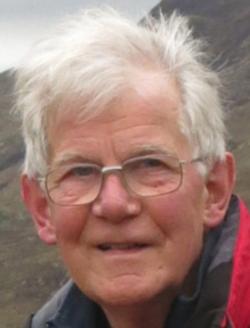
Bruce Campbell Ogilvie was born in Edinburgh and educated at George Heriot’s School. After considering a variety of possible careers including forestry and meteorology, towards the end of his school years, he had the opportunity to spend time at his uncle’s clinics and subsequently decided to study medicine. He started at the University of Edinburgh in 1959, where he also played rugby for the medical school. After graduating, apart from a year in obstetrics and neonatology, Bruce undertook his initial postgraduate training in general medicine in Galashiels, Edinburgh, and Kirkcaldy. He gained his membership of the Royal College of Physicians of Edinburgh with cardiology as his special subject, and as medical registrar in Kirkcaldy he helped establish one of the first coronary care units in a district general hospital in the UK.
The idea of the diagnostic detective poring over clues in a darkened room à la Sherlock Holmes appealed to him, however, and he came to see cardiac radiology as a specialty ripe for development and more suited to his talents than cardiology. During his subsequent radiology training in Edinburgh he developed expertise in cardiac catheterisation and coronary angiography as a collaborator in the European Coronary Artery Bypass Graft Trial. In 1976 he was headhunted by the radiologists and cardiac surgeons in Southampton, and he moved there with his first wife, Marie (a virologist), to take up a consultant post at the Wessex Cardiothoracic Unit, then based at the Western Hospital and later relocated to Southampton General Hospital in 1983. Living by the Solent, he developed a keen interest in sailing, an activity that led to a radiological cautionary tale years later when he bruised his chest while descending into the cabin of a yacht in choppy conditions. Unable to resist the temptation of a chest x ray to look for rib fractures, he was taken aback to find an unexpected mediastinal mass—a discovery that led to surgery for ectopic thyroid and hormone replacement thereafter.
Bruce was lead cardiothoracic radiologist in Southampton for 20 years and clinical services director for radiology for three years. His commitment and his combination of diagnostic and practical skills were instrumental in developing better services for patients with chest and heart disease in the region. He worked closely with colleagues in respiratory medicine, thoracic surgery and radiology in pursuing a multidisciplinary approach to managing malignancies, advocating for and developing thoracic computed tomography, and developing a thoracic needle biopsy service and new procedures, such as aerodigestive stenting. On the cardiac side, alongside developing coronary angioplasty—also a cutting edge technique at the time—with the cardiologists, he worked with the paediatric cardiologists, surgeons, and pathologists in advancing the understanding and treatment of paediatric heart disease, and with radiology colleagues in developing one of the first 24-hour emergency cardiac magnetic resonance imaging services in the UK. By the end of his career, therefore, cardiothoracic radiology had become a service with great diagnostic and interventional significance in the acute setting and a correspondingly demanding emergency workload. Bruce also set up the Southampton Radiology Teaching Library and lectured and taught locally, nationally, and internationally, including as visiting professor at the University of North Carolina. He was a founding committee member of the British and European societies of cardiothoracic radiology, and later chair of the British society, as well as secretary of the Society of Chest Radiologists and regional secretary and chair, and later national council member, of the British Institute of Radiology.
On his retirement in 2006 Bruce moved with his second wife, Rosemary (a nurse), to the Scottish Borders, where he enjoyed renewing old friendships, treading the boards with the Melrose Amateur Operatic Society, and hillwalking. He completed the Great Outdoors Challenge twice; this entailed crossing Scotland from coast to coast. He was diagnosed with colorectal cancer in 2010, and after his initial treatment and a discouraging prognosis, he was grateful for five years of good health to pursue his many interests before the eventual progression of the disease in the last 18 months of his life. He will be remembered by his colleagues and trainees as a knowledgeable and patient leader, teacher and mentor and a much missed friend. He leaves his wife, Rosemary; two sons (one a public health physician); two stepsons; and six grandchildren.
Biography
Consultant cardiothoracic radiologist Southampton (b 1941; q Edinburgh 1965; FRCP Ed, FRCR), died from metastatic colorectal cancer on 14 July 2017.
David Ogilvie
This obituary and photograph was originally published in the BMJ 2017; 359: j4883. http://www.bmj.com/content/359/bmj.j4883 and is reproduced with permission
